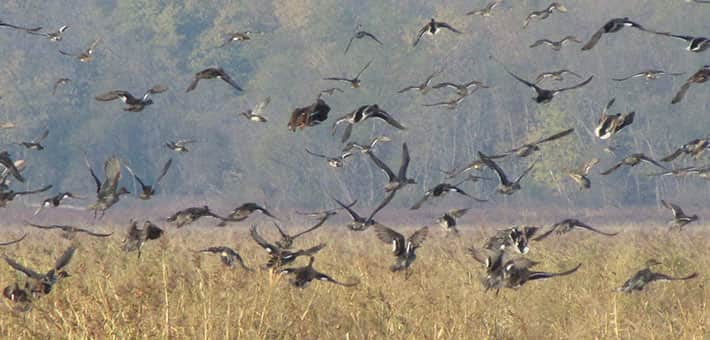Two Rivers National Wildlife Refuge an Overwhelming Success for Waterfowl
OutdoorHub 12.06.12

Biologists at Two Rivers National Wildlife Refuge have determined that the summer drawdown performed on Swan Lake was an overwhelming success based on exceptional amounts of natural seed production by wetland plants and high levels of bird use during the early part of the 2012 fall waterfowl migration.
The backwaters of the Illinois River that make up Swan Lake are an important migration stop along the Mississippi flyway. Located near Grafton, Ill., the lake is managed by Two Rivers National Wildlife Refuge part of the U.S. Fish and Wildlife Service.
U.S. Fish and Wildlife Service biologists Ken Dalrymple and Brian Loges, in collaboration with researchers from the University of Tennessee, report that seed production by plants grown in Swan Lake averaged more than 3,000 pounds per acre. This is an unprecedented amount of natural food for waterfowl. Typically native moist-soil plants growing in wetlands similar to Swan Lake produce less than half of the production reported from this summer’s growing season.
The report states 164,120 ducks could use Swan Lake for 110 days based on available seed.
“Most refuges cannot sustain this number of birds without providing supplemental corn,” stated Matthew Gray, Ph.D. from the University of Tennessee. “In other words, the drawdown of lower Swan Lake will provide significant quality habitat for migrating waterfowl this winter!”
A drawdown is a wetland management technique performed by slowly removing water from a wetland for the summer season to dry out the sediment at the bottom and promote plant growth. The ability of the refuge staff to complete a drawdown on the lower half of Swan Lake was enhanced by the summer drought. A drawdown could not be completed in recent years due to extended flooding on the Illinois River.
In addition to waterfowl, many other bird groups benefit from the flush of vegetation and insects following the drawdown.
“Estimating and then monitoring the number of waterfowl that can be supported in the lake are useful exercises to measure success towards the refuge’s waterfowl habitat goals,” said U.S. Fish and Wildlife Service Regional Zone Biologist Brian Loges. “Refuge management centers on evaluating how the resources of the refuge can help support the needs of migrating waterfowl.”
From weekly aerial counts the Illinois Natural History Survey has reported on average 108,000 ducks for the past three weeks on Swan Lake while ground survey estimates have been routinely higher. The aerial counts are performed by flying over a number of waterfowl survey areas. View these counts and others online by following the link at: http://www.fws.gov/refuge/Two_Rivers/seasons_of_wildlife/index.html.
“Other factors such as ice and water levels can influence bird abundance on the lake but an adequate food supply in Swan Lake should not be a limiting factor for the remainder of the fall migration,” said Loges.

